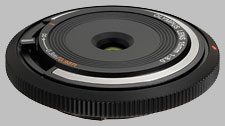| 15mm |
$80 average price |
|---|---|

|
|
Your purchases support this site
Micro Four Thirds - Black
SLRgear Review
December 17, 2012
by Andrew Alexander
Introduced in September 2012, the Olympus 15mm ƒ/8 is a simple and interesting lens - a super-small and inexpensive optic that also doubles as a body cap. It's a fixed-aperture lens designed for the micro four-thirds lens mount, with just three lens elements.
The lens will mount on Olympus and Panasonic cameras that share the micro four-thirds lens. It's available for $49 and comes with only a lens cap as an accessory.
Sharpness
Olympus has obviously had to make some concessions for this tiny lens. There's a small sweet spot of sharpness in the center of the image, followed by some light softness extending out to the corners.
Chromatic Aberration
There is some significant chromatic aberration to note when using this lens, but fortunately it's restricted to the corners. It shows up as green fringing in areas of high contrast.
Shading (''Vignetting'')
Images shot with this lens show corners that are slightly darker than the central region of the image: about 2/3 of a stop darker.
Distortion
There's some light barrel distortion when using this lens, about +0.5% in the corners.
Autofocus Operation
The Olympus 15mm ƒ/8 body cap lens does not provide autofocus.
Macro
This lens is not one you would flock to for macro performance: just 0.12x magnification, with a minimum focusing distance of 30 cm (around a foot).
Build Quality and Handling
The Olympus 15mm ƒ/8m body cap lens is the smallest (and least expensive) lens we have tested on SLRgear. At just 9mm thick and around 22 grams in weight, it's not surprising that Olympus puts the lens in the accessories category on its website instead of the lens category. Since the lens has no electrical contacts, you will get the “lens not found” message on Olympus cameras. To use the lens, you must go in the custom menu and set the “SHOOT W/O LENS option to “on”. Unsurprisingly, there are no filter threads, so it's not possible to mount filters, though you could probably tape a piece of gelatin in place.
The lens is made up of three separate elements, one of which is moved manually by a lever to control focus. This lever also controls a built-in lens cap. The focus lever has four marked positions it can be set to: a: close the lens(red line), b: infinity focus(infinity symbol), c: distant focus(white dot), d: close focus (0.3m/0.98ft). The lever can be moved anywhere between distant focus and close focus.
Rob took the lens out with a GX-1 for a day of shooting, and this is what he had to say:
I had a lot of fun using this lens on the Panasonic GX1 test camera. Manual focusing was easy using the magnified view on the LCD. Finding the tiny focus lever was harder than using it. All shots were in good focus and well exposed. The camera and lens combo was easy to fit into my pants pocket or jacket pocket when not in use. I wish they had put a tiny AF motor in there and a little faster (f5.6) lens, but its still a very useful lens for only $49!
    |
Alternatives
Olympus 25mm ƒ/2.8 Zuiko Digital ~$250
The Olympus 25mm doesn't offer the same field of view, but a similar form factor to the body cap lens: it's much more expensive, but it offers a conventional aperture (ƒ/2.8-ƒ/22) and autofocus. At the ƒ/8 setting, the lens is a fair bit sharper than the Olympus 15mm ƒ/8. Chromatic aberration is much better on the 25mm Zuiko; there is also less distortion and corner shading.
Panasonic 14mm ƒ/2.5 ASPH LUMIX G ~$400
It's much more expensive, but for the price you get a conventional aperture (ƒ/2.5-ƒ/22) and autofocus. At the ƒ/8 setting, the lens is tack-sharp compared to the Olympus 15mm ƒ/8. Chromatic aberration is a bit more severe on the Panasonic.
Conclusion
It's an interesting idea that seems to work well: instead of putting a body cap on your micro four thirds camera, put on this body cap lens, creating an ultra-portable point and shoot style camera. Recommended!
Product Photos
     |
Sample Photos
The VFA target should give you a good idea of sharpness in the center and corners, as well as some idea of the extent of barrel or pincushion distortion and chromatic aberration, while the Still Life subject may help in judging contrast and color. We shoot both images using the default JPEG settings and manual white balance of our test bodies, so the images should be quite consistent from lens to lens.
As appropriate, we shoot these with both full-frame and sub-frame bodies, at a range of focal lengths, and at both maximum aperture and ƒ/8. For the ''VFA'' target (the viewfinder accuracy target from Imaging Resource), we also provide sample crops from the center and upper-left corner of each shot, so you can quickly get a sense of relative sharpness, without having to download and inspect the full-res images. To avoid space limitations with the layout of our review pages, indexes to the test shots launch in separate windows.
Olympus 15mm f/8 BCL-1580 Body Cap Lens
Your purchases support this site
Micro Four Thirds - Black
Olympus 15mm f/8 BCL-1580 Body Cap Lens User Reviews
-
good & small jokeno AF, no Aperture, no electronics
nice idea - the most expensive camera-cap.
reviewed December 30th, 2012 (purchased for $80)





